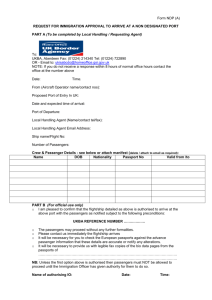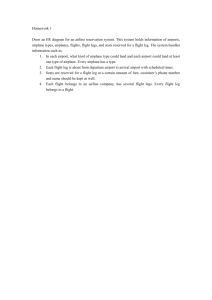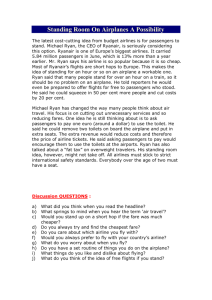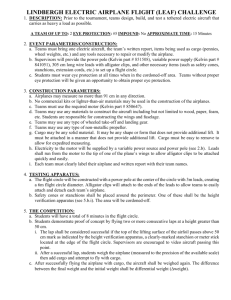The Boeing 777 Family: Preferred by Passengers and Airlines
advertisement
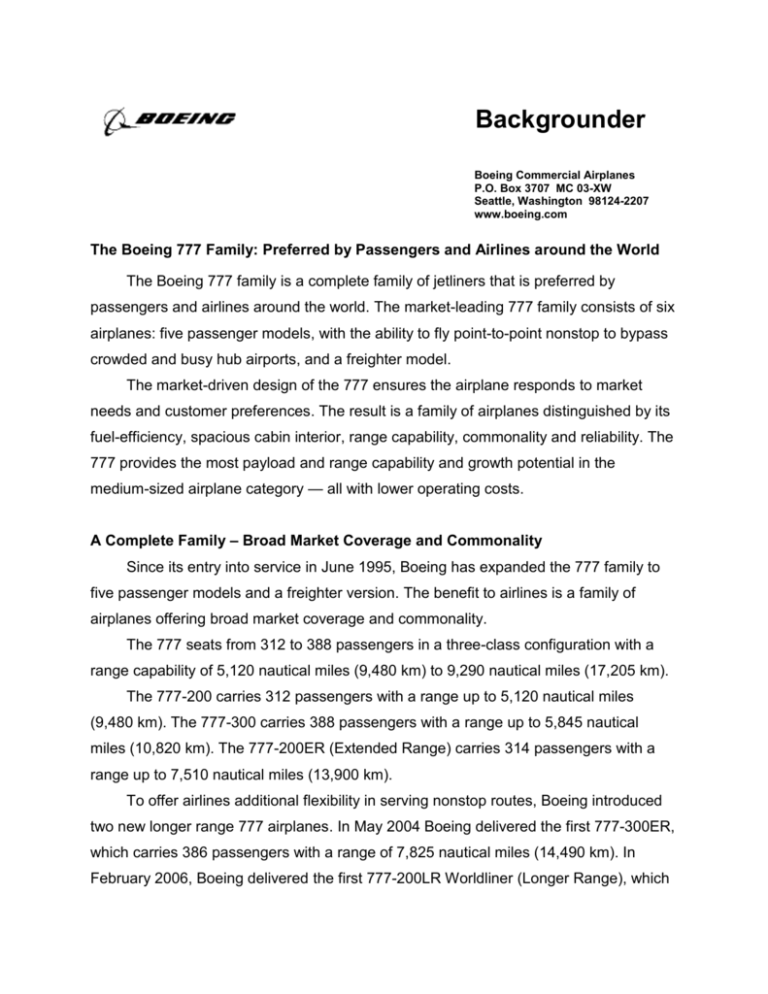
Backgrounder Boeing Commercial Airplanes P.O. Box 3707 MC 03-XW Seattle, Washington 98124-2207 www.boeing.com The Boeing 777 Family: Preferred by Passengers and Airlines around the World The Boeing 777 family is a complete family of jetliners that is preferred by passengers and airlines around the world. The market-leading 777 family consists of six airplanes: five passenger models, with the ability to fly point-to-point nonstop to bypass crowded and busy hub airports, and a freighter model. The market-driven design of the 777 ensures the airplane responds to market needs and customer preferences. The result is a family of airplanes distinguished by its fuel-efficiency, spacious cabin interior, range capability, commonality and reliability. The 777 provides the most payload and range capability and growth potential in the medium-sized airplane category — all with lower operating costs. A Complete Family – Broad Market Coverage and Commonality Since its entry into service in June 1995, Boeing has expanded the 777 family to five passenger models and a freighter version. The benefit to airlines is a family of airplanes offering broad market coverage and commonality. The 777 seats from 312 to 388 passengers in a three-class configuration with a range capability of 5,120 nautical miles (9,480 km) to 9,290 nautical miles (17,205 km). The 777-200 carries 312 passengers with a range up to 5,120 nautical miles (9,480 km). The 777-300 carries 388 passengers with a range up to 5,845 nautical miles (10,820 km). The 777-200ER (Extended Range) carries 314 passengers with a range up to 7,510 nautical miles (13,900 km). To offer airlines additional flexibility in serving nonstop routes, Boeing introduced two new longer range 777 airplanes. In May 2004 Boeing delivered the first 777-300ER, which carries 386 passengers with a range of 7,825 nautical miles (14,490 km). In February 2006, Boeing delivered the first 777-200LR Worldliner (Longer Range), which carries 314 passengers up to 9,290 nautical miles (17,205 km). The 777-200LR, as the world’s longest-range commercial jetliner, is capable of connecting virtually any two city pairs around the globe. In May 2005, Boeing launched the 777 Freighter. Based on the 777-200LR platform, the 777 Freighter flies 4,900 nautical miles (9,070 km) with a full payload at general cargo market densities — making it the world’s most capable twin-engine freighter. The airplane entered service in February 2009. Wing Design The advanced wing design for the 777, with a span of 199 feet 11 inches (60.9 m), enhances its ability to achieve higher cruise speeds, climb quickly and cruise at higher altitudes than competing airplanes. It also allows the airplane to carry full passenger payloads out of many high-elevation, high-temperature airfields. Raked 6.5-foot (1.9-m) wingtips have been added to the 777-200LR and 777-300ER to improve the overall aerodynamic efficiency of the wing. The raked wingtips help reduce takeoff field length, increase climb performance and reduce fuel burn. Twin-Engine Design — Fuel Efficient, Quiet and Reliable Three engine manufacturers developed more efficient and quieter turbofans to power the 777. General Electric offers its GE90 series, Rolls-Royce offers the Trent 800 series of engines and Pratt & Whitney offers the PW4000 series. For the longer range 777 models and the Freighter, GE is the exclusive engine supplier with its GE90-115B and GE90-110B. All three engine types offer excellent fuel efficiency. Key factors in this performance are new, larger-diameter fans with wide-chord fan blade designs and bypass ratios ranging from six-to-one to as high as nine-to-one. This compares to the typical five-to-one ratio for the engines of previous twin-aisle jets. Lighter by Design The 777 makes extensive use of lightweight, cost-effective structural materials that lessen the overall weight of the airplane and contribute to the fuel efficiency of the 777. For example, an improved aluminum alloy is used in the upper wing skin and stringers. Known as 7055, this alloy offers greater compression strength than previous alloys, enabling designers to save weight and also improve corrosion and fatigue resistance. Progress in the development and fabrication of weight-saving advanced composite materials is evident in the 777. Carbon fibers embedded in recently available toughened resins are found in the vertical and horizontal tails. The floor beams of the passenger cabin also are made of these advanced composite materials. Other composite applications include those on secondary structures such as aerodynamic fairings. Composites, including resins and adhesives, account for nine percent of the 777's structural weight. This is the same type of composite material used on the 787 Dreamliner. Flight Deck and Airplane Systems In response to airline preference, the layout of the 777 flight deck is in a horizontal format. Principal flight, navigation and engine information is presented on six large display screens. The depth of the new "flat panel displays" is about half that of CRTs. In addition to saving space, the new displays weigh less and require less power. They also generate less heat, which contributes to greater reliability and a longer service life. As another benefit, the displays do not require the heavy, complex air conditioning apparatus needed to cool equipment on previous flight decks. Pilots appreciate that flat panel displays remain clearly visible in all conditions, even direct sunlight. Three multipurpose control display units (CDU), installed in the center aisle stand, provide data display and entry capabilities for flight management functions. These units are the primary interface with an integrated Airplane Information Management System (AIMS). The CDUs have color displays, again in response to market preferences. Adding color allows pilots to assimilate the information more quickly. AIMS provides flight and maintenance crews all pertinent information concerning the overall condition of the airplane, its maintenance requirements and its key operating functions, including flight, thrust and communications management. The flight crew transmits control and maneuvering commands through electrical wires, augmented by computers, directly to hydraulic actuators for the elevators, rudder, ailerons and other control surfaces. This three-axis "fly-by-wire" flight control system saves weight, simplifies factory assembly compared to conventional mechanical systems relying on steel cables, and requires fewer spares and less maintenance in airline service. A key part of the 777 systems is a Boeing-patented two-way digital data bus, which has been adopted as a new industry standard: ARINC 629. It permits airplane systems and associated computers to communicate with one another through a common wire path (a twisted pair of wires) instead of through separate one-way wire connections. This further simplifies assembly and saves weight, while increasing reliability through a reduction in the amount of wires and connectors. There are 11 of these ARINC 629 pathways in the 777. The 777 was the first Boeing model to be equipped with the Enhanced Ground Proximity Warning System (EGPWS) as standard equipment. The EGPWS displays potentially threatening terrain and gives an audible alert up to a minute in advance of possible terrain conflict, compared with 10 to 15 seconds for previous systems. It incorporates a proprietary digital terrain map, which it continuously compares to aircraft position data from the navigation system. A feature unique to the 777-300ER and 777-300 flight deck is the Ground Maneuver Camera System (GMCS), designed to assist the pilot in ground maneuvering of the 777-300 with camera views of the nose gear and main gear areas. The cameras are on the leading edge of the left and right horizontal stabilizers and the underside of the fuselage and are used during ground maneuvering. The images are displayed at the Multi-Functional Display positions in the flight deck in a three-way split format. Award Winning Cabin Design In addition to being one of the most spacious passenger cabins ever developed, the 777 interior offers operators unsurpassed configuration flexibility. Flexibility zones have been designed into the cabin areas specified by the airlines, primarily at the airplane's doors. In one-inch increments, galleys and lavatories can be positioned anywhere within these zones, which are pre-engineered to accommodate wiring, plumbing and attachment fixtures. Passenger service units and overhead stowage compartments are designed for quick removal without disturbing ceiling panels, air conditioning ducts or support structure. A typical 777 configuration change is expected to take as little as 72 hours, while such a change might take two to three weeks on other airplanes. Large overhead compartments provide passengers with increased stowage capacity. Outboard as well as center stowage units are designed to open downward for convenient loading. When closed, they fit neatly into the streamlined contours of the interior architecture and allow ample overhead clearance. For improved, more efficient in-flight service, the 777 is equipped with an advanced cabin management system. Linked to a computerized control console, the cabin management system assists cabin crews with many tasks and allows airlines to provide new services for passengers, including a digital sound system comparable to the most state-of-the-art home stereo or compact disc players. Surveys of passengers on long-range routes continue to show that those passengers prefer to travel on the 777 compared to other available airplanes. Readers of Executive Travel magazine voted the 777 as “Best Aircraft Type” for five years in a row (2008-2013). The awards were based on the votes of the publication’s readers, who selected their top choices in 54 categories over a six-month period. Landing Gear The main landing gear for the 777 is in a standard two-post arrangement but features six-wheel trucks, instead of the conventional four-wheel units. This provides the main landing gear with a total of 12 wheels for better weight distribution on runways and taxi areas, and avoids the need for a supplemental two-wheel gear under the center of the fuselage. The 777’s landing gear is the largest ever incorporated into a commercial airplane. The longer range 777s share a new and improved gear. Because of its longer length, the 777-300ER uses a new semi-levered gear, which allows it to take off from fields with limited runway length. High Reliability and Quality New design and testing initiatives helped ensure the highest possible levels of reliability on the very first 777, compared to what had been possible on previous jetliner introductions. Today’s 777 operators enjoy a better than 99 percent dispatch reliability rate, which is unmatched in the industry. Design/build teams, which bring together representatives of the diverse disciplines involved in airplane development, as well as suppliers and representatives of airline customers, allowed team members to work concurrently on the 777 structural and systems designs. 777 Family Technical Characteristics PASSENGERS Typical 3-class configuration Typical 2-class configuration Typical 1-class configuration Cargo Engines (Maximum thrust) Maximum Fuel Capacity Maximum Takeoff Weight Maximum Range Typical Cruise Speed (at 35,000 feet) Basic Dimensions Wing span Overall length Tail height Interior cabin width Diameter 777-200 777-200ER 777-300 312 399 up to 440 Total volume 5,330 ft3 (151 m3) includes up to six pallets, 14 LD-3 containers, plus 600 ft3 (17 m3) bulk cargo 314 400 up to 440 Same as -200 Pratt & Whitney 4077 77,000 lb Rolls-Royce Trent 877 76,000 lb GE GE90-77B 77,000 lb 31,000 gallons (117,340 L) 545,000 pounds (247,200 kg) 5,120 nautical miles (9,480 km) Typical city pairs: London-New York Denver-Honolulu Tokyo-San Francisco Mach 0.84 Pratt & Whitney 4090 90,000 lb Rolls-Royce Trent 895 93,400 lb GE GE90-94B 93,700 lb 45,220 gallons (171,170 L) 656,000 pounds (297,550 kg) 7,510 nautical miles (13,900 km) Typical city pairs: London-Los Angeles Tokyo-Sydney Chicago-Seoul Same 388 491 up to 550 Total volume of 7,120 ft3 (202 m3) including eight 96-inch x 125inch pallets in forward lower hold, 20 LD-3 containers in aft lower hold, and 600 ft3 (17 m3) bulk cargo Pratt & Whitney 4098 98,000 lb Rolls-Royce Trent 892 90,000 lb GE90-94B 93,700 lb Same as –200ER 199 ft 11 in (60.9 m) 209 ft 1 in (63.7 m) 60 ft 9 in (18.5 m) 19 ft 3 in (5.86 m) 20 ft 4 in (6.19 m) Same Same Same Same Same ### May 2013 Contact: Everett Communications Office, +1 206-766-2913 660,000 pounds (299,370 kg) 5,845 nautical miles (10,820 km) Typical city pairs: Tokyo-Singapore; Honolulu-Seoul; San Francisco-Tokyo Same Same 242 ft 4 in (73.9 m) 60 ft 8 in (18.5 m) Same Same

